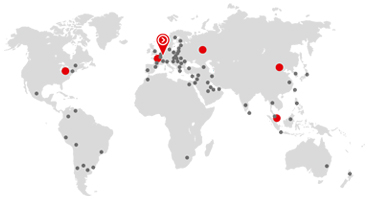Some samples are difficult to disperse. For example, they are statically charged (for example plastics) or have hydrophobic characteristics or water repellent molecule components (for example pharmaceuticals, drugs, toner powder, graphite, titanium dioxide).
With such samples, a spatula amount of the material should be added to a small 50 ml Erlenmeyer flask, then initially 1 (up to 2) drops of a wetting agent (surfactant) added, then mixed into a paste until the sample is completely wetted. Water is added drop by drop and stirred. The now created suspension (approximately 20 - 30 ml) is dispersed in an ultrasonic bath.
If the sample is already inside the dispersion unit and floats on the surface, the sample can be wetted as follows: With a glass rod or with the tip of a spatula, a small drop of the wetting agent is added to the liquid of the surface and distributed. Immediately the formed skin on the surface breaks open and the fine portion enters the suspension.
-
Detailed dispersion tips
Sample preparation for the Laser Particle Sizer ANALYSETTE 22
-
Instrument-Recommendation




